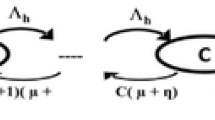Abstract
A high priority real-time connection is denied admission to an ATM network if sufficient bandwidth is not available along all suitable paths through the network. Bandwidth reallocation and dynamic active channel re-routing are techniques that can be used to admit high priority real-time connections where traditional CAC techniques would deny admission. A node can select lower priority channels, reallocate their bandwidth to the new higher priority connection being admitted, and reroute those channels so that their QoS requirements and transmission deadlines can still be satisfied. At call admission time, one or more backup channels are established for those primary channels that are likely to be selected as victims for bandwidth reallocation. This allows reroutes to be handled quickly and efficiently. When reroutes occur, the protocols ensure that the transmitted data are received on time and in sequence, which is essential for real-time communications. SANRoP, a cell based discrete event simulator, was developed to simulate these protocols in an ATM network in order to determine how well they perform.
Access this chapter
Tax calculation will be finalised at checkout
Purchases are for personal use only
Preview
Unable to display preview. Download preview PDF.
Similar content being viewed by others

References
J. Anderson, B. Doshi, S. Dravida, and P. Harshavadhana, “Fast restoration of ATM networks” IEEE Journ. on Selected Areas in Communications, vol. 12, no.1, pp. 128–138, January 1994.
J. Baker, “A distributed link restoration algorithm with robust preplanning” Proc. IEEE GLOBECOM, pp. 306–311, 1991.
A. Banerjea, C. Paris, and D. Ferrari, “Recovering guaranteed performance service connections from single and multiple faults” Technical Report TR-93-066, UC Berkeley, 1993.
A. Banerjea, “Simulation study of the capacity effects of dispersity routing for fault tolerant real-time channels” Proc. ACM SIGCOMM, pp. 194–205, August1996.
I. Cidon, and R. Rom, “Multi-Path Routing combined with Resource Reservation”, IEEE INFOCOMM 97, pp. 92–100, 1997.
W. Glover, “The selfhealing network: A fast distributed restoration technique for networks using digital crossconnect machines” Proc. IEEE GLOBECOM, pp.1090–1095, 1987.
R. A. Guerin, A. Orda, “QoS Routing in Networks with Inaccurate Information: Theory and Algorithms”, IEEE Trans. on Networking, vol. 7, No. 3, pp. 350–364, 1999.
S. Han, and K.G. Shin, “Efficient Spare-Resource Allocation for Fast Restoration of Real-Time Channels from Network Component Failures” Proc. IEEE RTSS 97, pp. 99–108, 1997.
S. Han and K.G. Shin, “Fast Restoration of Real-Time communication Service from Component Failures in Multi-hop Networks” Proc. ACM SIGCOMM, pp.77–88, 1997.
R. Iraschko, M. MacGregor, and W. Grover, “Optimal capacity placement for path restoration in mesh survivable networks,” Proc. IEEE ICC, pp. 1568–1574,1996.
R. R. Iraschko, M.H. MacGregor, and W. D. Grover, “Optimal Capacity Placement for Path Restoration in STM or ATM Mesh-Survivable Networks”, IEEE Trans. on Networking, vol. 6, no. 3, pp.325–336 1998.
B. Kao, H. Garcia-Molina, and D. Barbara, “Aggressive transmissions of short messages over redundant paths” IEEE Trans. Parallel and Distributed Systems, vol. 5, no. 1, pp. 102–109, January 1994.
R. Kawamura, K. Sato, and I. Tokizawa, “Self-healing ATM networks based upon virtual path concept” IEEE Journ. on Selected Areas in Communications, vol. 12, no. 1, pp. 120–127, January 1994.
D. H. Lorenz, A. Orda, “QoS Routing in Networks with Uncertain Parameters”, IEEE Trans. on Networking, vol. 7, No. 3, pp. 768–778, 1999.
L. Miller, and A. M. K. Cheng, “CAC with Bandwidth Reallocation and Active Channel Rerouting Techniques in ATM Networks: Simulation and Performance Results” IASTED Applied Simulation &Modelling 2000, pp. 184–190, 2000.
L. Miller, and A. M. K. Cheng, “Admission of High Priority Real-Time Calls in an ATM Network via Bandwidth Reallocation and Dynamic Rerouting of Active Channels”, IEEE RTSS 2000, pp. 249–258, 2000.
K. Murakami, and H. Kim, “Near-optimal virtual path routing for survivable ATM networks” Proc. IEEE INFOCOMM, pp. 208–215, 1994.
A. Orda, “Routing with End-to-End QoS Guarantees in Broadband Networks”, IEEE Trans. on Networking, vol. 7, No. 3, pp. 365–374, 1999.
P. Ramanathan, and K.G. Shin, “Delivery of time-critical messages using a multiple copy approach” ACM Trans. Computer Systems, vol. 10, no. 2, pp.144–166, May 1992.
R. Vogel, R. Herrtwich, W. Kalfa, H. Wittig, and L. Wolf, “QoS-Based routing on multimedia streams in computer networks” IEEE Journ. on Selected Areas in Communications, vol. 14, no. 7, pp. 1235–1244, Sept. 1996.
C. Yang, and S. Hasegawa, “FITNESS: Failure immunization technology for network service survivability” Proc. IEEE GLOBECOM, pp. 1549–1554, 1988.
Q. Zheng, and K.G. Shin, “Fault-tolerant real-time communication in distributed systems” Proc. IEEE FTCS, pp. 86–93, 1992.
Author information
Authors and Affiliations
Editor information
Editors and Affiliations
Rights and permissions
Copyright information
© 2001 Springer-Verlag Berlin Heidelberg
About this paper
Cite this paper
Miller, L.K., Leiss, E.L. (2001). Bandwidth Reallocation Techniques for Admitting High Priority Real-Time Calls in ATM Networks. In: Lorenz, P. (eds) Networking — ICN 2001. ICN 2001. Lecture Notes in Computer Science, vol 2093. Springer, Berlin, Heidelberg. https://doi.org/10.1007/3-540-47728-4_54
Download citation
DOI: https://doi.org/10.1007/3-540-47728-4_54
Published:
Publisher Name: Springer, Berlin, Heidelberg
Print ISBN: 978-3-540-42302-7
Online ISBN: 978-3-540-47728-0
eBook Packages: Springer Book Archive



